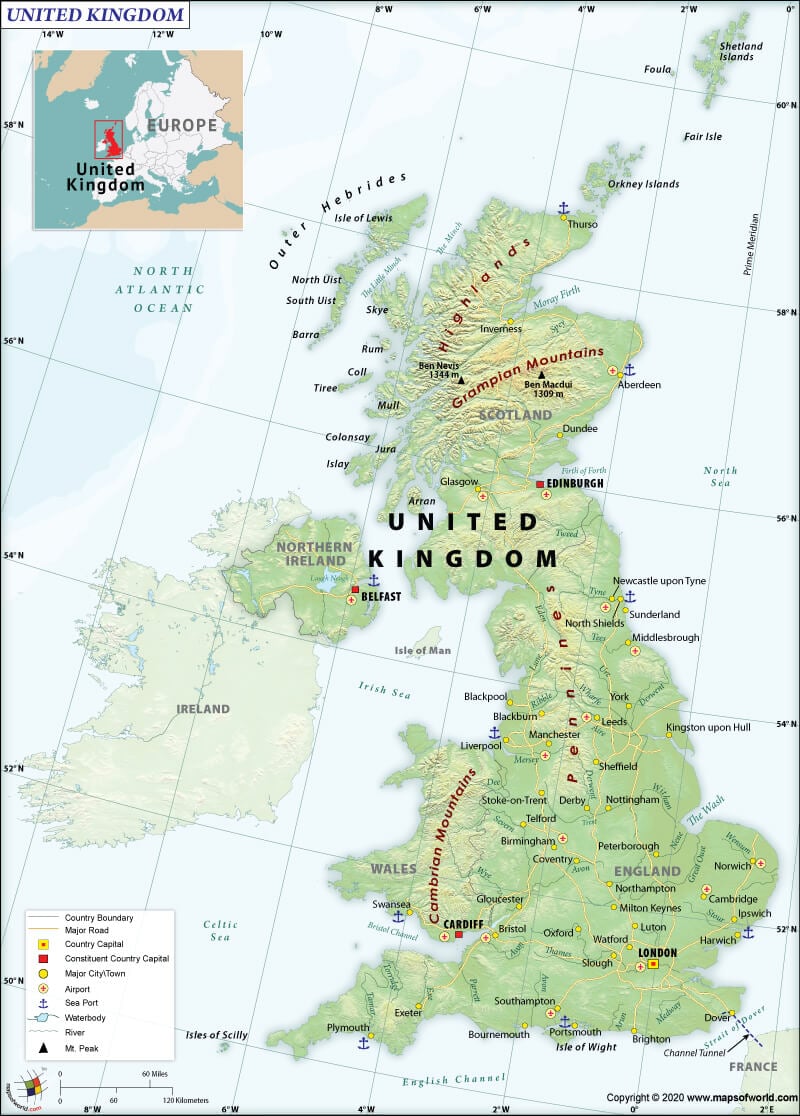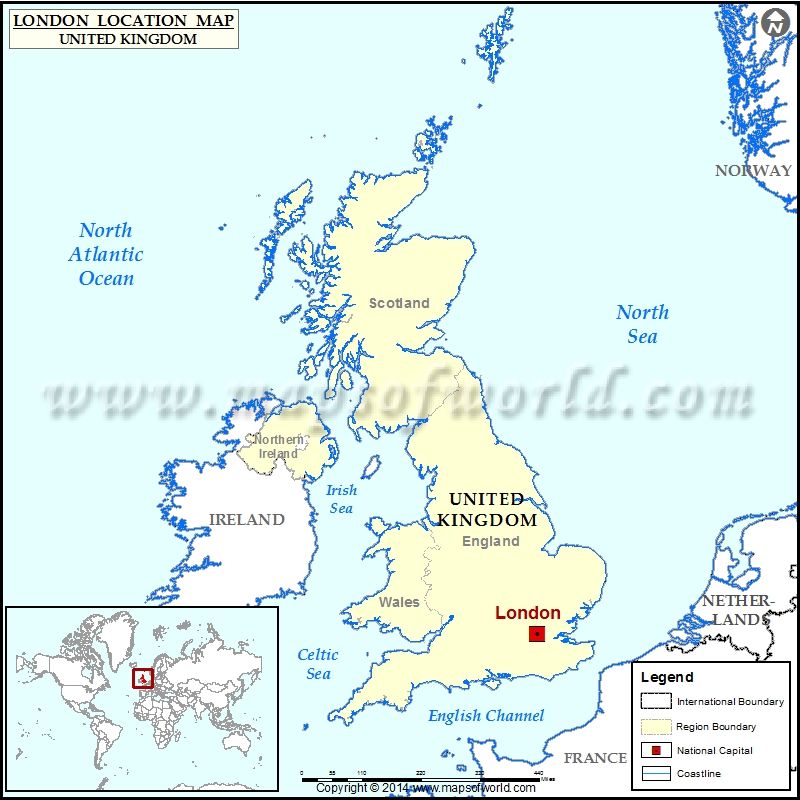What are the Key Facts of The United Kingdom?

|
Official Name |
United Kingdom of Great Britain and Northern Ireland |
|
Continent |
Europe |
|
Capital |
London |
|
Largest City |
London |
|
Coordinates |
54.000000, -2.000000 |
|
Area |
93,628 sq. mi ( 242,495 sq. km) |
|
Land Boundaries |
304 mi ( 490 km) |
|
Coastline |
7,723 mi ( 12,429 km) |
|
Currency |
Pound sterling (GBP; £) |
|
Neighboring Countries |
Ireland. Maritime Neighbors: Belgium, Denmark, France, Germany, Netherlands, Norway, Faroe Islands (Denmark) |
|
Population |
66,834,000 (World Bank, 2019) |
|
Official Languages |
English |
|
Major Religion |
Christianity |
|
National Day |
No single official day |
|
National Anthem |
“God Save the Queen” |
|
Form of Government |
Unitary parliamentary constitutional monarchy |
|
Monarch |
Elizabeth II |
|
Prime Minister |
Boris Johnson |
|
GDP per capita (PPP) |
$ 48,709.7 (World Bank, 2019) |
|
GDP per capita (nominal) |
$ 42,300.3 (World Bank, 2019) |
|
HDI |
0.920 (2019), Rank: 15 |
|
Literacy Rate (%) |
NA |
|
Space Agency |
UK Space Agency (UKSA) |
|
Military Expenditure Ranking |
8 (SIPRI, 2019) |
|
No. of Olympic Medals |
883 (as of 2018) |
|
Driving Side |
left |
|
Calling Code |
44 |
|
Time Zone |
UTC (GMT), Summer (DST) UTC+1 (WEST) |
|
Internet TLD |
.uk |
Where is the United Kingdom?
The United Kingdom (UK) comprises four countries: England, Scotland, Wales and Northern Ireland. London is its capital, considered a leading commercial, financial, and cultural centre in the world. The UK is situated in the western part of the European continent. The prime meridian also called the Greenwich Meridian, or the International Meridian passes through the UK. Check out this – Uk Map and Other 97 Related British Maps for more maps and info about the United Kingdom.
United Kingdom Square Miles
The United Kingdom in square miles covers an area of 93,628 square miles.
Scotland, which is located in the northern part of the United Kingdom, shares its borders with England as represented in the map of the United Kingdom. Edinburgh is the capital of Scotland, while Glasgow is its largest city. Scotland covers an area of 30,090 square miles.
England shares its borders with Scotland and Wales. It comprises around 84 percent of the population of the United Kingdom and covers five-eighths of the island of Great Britain. Its capital, and the largest city, London is also the capital of the United Kingdom. The largest of the four countries, England covers an area of 50,301 square miles.
Wales shares its land border with England and covers an area of 8,023 square miles. Cardiff is its capital as well as the largest city. Northern Ireland, which comprises 3 percent of the population of the United Kingdom, shares its land border with the Republic of Ireland. Northern Ireland covers an area of 5,460 square miles and Belfast is its capital as well as the largest city.
The UK shares its maritime borders with Belgium, Denmark, France, Germany, the Netherlands, Norway, and the Faroe Islands (Denmark). Since 1994, the Channel Tunnel beneath the English Channel has linked the UK with France.
What is the Geography of the UK?
The total area of the United Kingdom is approximately 242,495 sq. km (93,628 sq. mi). Of this, the total land area is 241,930 sq. km (93,409 mi) and water bodies occupy 1,680 sq. km (649 sq. mi). The southern and western parts of the UK are covered with high ground, and knife-edged mountain ridges separated by deep valleys. Scotland and Wales are the areas well known for their mountains. A ridge of hills named Pennine runs down the center of northern England. Most of the coastal areas of the UK are low-lying, especially in the east and the south of England.
The topography of the UK is made up of rugged underdeveloped hills and low mountains. But there is plenty of flat and gently rolling plains in the countryside, especially the eastern and southeastern areas of the country. Ben Nevis is considered the highest point of the UK. Its height is 4,406 feet (1,343 m), and it is situated in the northern part of the UK comprising Scotland.
The natural beauty of the UK is unbelievable. It is replete with beautiful lakes. England’s largest and deepest lakes are the Windermere and Wastwater respectively. Wastwater is 79 m (259 ft) deep. Incidentally, both lakes are in the Lake District National Park.
In Scotland, lakes are called ‘lochs’, while in Northern Ireland the pronunciation is the same, but the word is spelled as ‘loughs’. A lake is known as Llyn in Wales. There are approximately 31,460 freshwater lochs (lakes) in Scotland.
The rivers in the UK are not very long. The Severn is considered its longest river, 354 km (220 mi) in length. Another famous river is the Thames. London is situated on the banks of this river. The Thames flows into the North Sea, and its length is 346 km (215 mi). It is the deepest river in Britain.
The climate in the UK is variable. It depends on the season and the location. However, the UK is famous for having cloudy and rainy weather most of the time. The western part is the wettest and windy. The average temperature of the UK ranges from 9-18°C (48-64°F) in summer. Sometimes it can reach up to 30°C (86°F) during a heatwave.
The wettest places in the UK with an average rainfall of over 3,000 mm (118 inches) are in western Scotland, northwest England, and north Wales. In general terms, four seasons can be distinguished in the UK. They are Spring (March to May), Summer (June to August), Autumn (September to November), and Winter (December to February).
What is the Economy of the UK?
The UK’s economy is highly developed as well as market-oriented. It is considered the third-largest economy in Europe after Germany and France. The GDP of the UK in 2018 was US$2.825 trillion. The GDP growth rate was quite low at 1.4% in 2018 (World Bank).
To begin with, the services sector in the UK contributes around 79% of the GDP. Business and financial services were the biggest contributors to the growth of the services sector in 2017. The tourism industry has also penetrated across the UK, especially London. In 2017, visitors spent £24.5 billion (US$31.76 billion) on travel and tourism in the U.K.
Generally, agriculture is also well developed in the UK. Overall, 69% of the land area is being used for agriculture. But this sector employs only 1.5% of its workforce. The contribution of the agriculture sector is just 0.62% of its gross value added (£9.9 billion). It is amazing that the UK yields less than 60% of the food it consumes.
Despite skilled farmers, modern technology, and fertile land, the earnings from the agriculture sector are relatively low, due to low prices at the farm gate. Young people are not taking much interest to work on the farmland. Of late, some steps have been taken to encourage people to adopt agriculture as a profession. One such is organic farming, which is expected to fetch more profits. One-tenth of the land area in the UK is devoted to productive forestry. The government is providing support and manages almost half of these woodlands, and the rest is in private hands.
Moreover, the UK is one of Europe’s leading fishing countries. However, the total contribution of the UK’s agriculture, forestry and fishing, and value-added to the GDP is less than 1%.
Manufacturing, automotive, aerospace, and pharmaceutical industries also play a major role in the UK economy. Industry together contributes 20% to the GDP of the UK. UK’s manufacturing sector grew 2.5% and construction grew 7.1% in 2017. The contribution of food production was 18.3% of the total manufacturing in the UK in 2017.
The United Kingdom is known for the export of cars, crude petroleum, gold, gas turbines, and so on. On the other hand, it must import machinery including computers, mineral fuels including oil, gems, precious metals, and so on.
Since the referendum vote to leave the European Union (EU) in June 2016, the UK economy is grappling with uncertainty. The recent developments in the UK regarding Brexit may push the UK economy into recession. In fact, the National Institute of Economic and Social Research (NIESR) has warned there is a one in four chance the country is already in a recession currently. It is undeniable that Brexit may further slow down the UK economy.
What is the Transportation System of the UK?
Transportation plays a vital role in the advancement of a country’s economy, and a high-quality transport network showcases the country’s economic strength.
Surely, the United Kingdom has a modern infrastructure for transportation. There are 22 train operating companies that provide rail services in the UK (expatica.com, 2018). The United Kingdom railway network is connected with Continental Europe through the channel tunnel. It has been operating since 1994. The UK is also a member of the International Union of Railways (UIC).
The railway system in the UK is one of the oldest in the world. Overall, 16,837 km (10.462 mi) in area is covered by the railway tracks. Of this, 5,357 km (3329 mi) is electrified.
The roadways network in the United Kingdom is also extensive. It comprises about 422,100 km (262,300 mi) roads, of which 3,519 km (2,187 mi) is the expressway.
Simultaneously, air transport in the UK is well established. The number of registered air carriers in the UK is 28. While the inventory of registered aircraft operated by air carriers is around 1,242, there are 460 airports in the UK. Airports with paved runways are 271, while airports with unpaved runways are 189.
Moreover, waterways in the UK comprise 3,200 km (1988 mi). Additionally, it has a total of 1570 merchant marine. In 2018, there were 129 bulk carriers, 109 container ships, 162 general cargo, 177 oil tankers, and 993 other ships.
What International Organizations is the UK part of?
ADB (non-regional member), AfDB (non-regional member), Arctic Council (observer), Australia Group, BIS, C, CBSS (observer), CD, CDB, CE, CERN, EAPC, EBRD, ECB, EIB, EITI (implementing country), ESA, FAO, FATF, G-5, G-7, G-8, G-10, G-20, IADB, IAEA, IBRD, ICAO, ICC (national committees), ICCt, ICRM, IDA, IEA, IFAD, IFC, IFRCS, IGAD (partners), IHO, ILO, IMF, IMO, IMSO, Interpol, IOC, IOM, IPU, ISO, ITSO, ITU, ITUC (NGOs), MIGA, MINUSMA, MONUSCO, NATO, NEA, NSG, OAS (observer), OECD, OPCW, OSCE, Pacific Alliance (observer), Paris Club, PCA, PIF (partner), SELEC (observer), SICA (observer), UN, UNCTAD, UNESCO, UNFICYP, UNHCR, UNMISS, UNRWA, UN Security Council (permanent), UPU, WCO, WHO, WIPO, WMO, WTO, ZC
Related Links:



